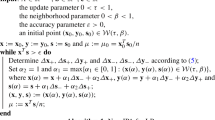Abstract
As noted by Wächter and Biegler (Ref. 1), a number of interior-point methods for nonlinear programming based on line-search strategy may generate a sequence converging to an infeasible point. We show that, by adopting a suitable merit function, a modified primal-dual equation, and a proper line-search procedure, a class of interior-point methods of line-search type will generate a sequence such that either all the limit points of the sequence are KKT points, or one of the limit points is a Fritz John point, or one of the limit points is an infeasible point that is a stationary point minimizing a function measuring the extent of violation to the constraint system. The analysis does not depend on the regularity assumptions on the problem. Instead, it uses a set of satisfiable conditions on the algorithm implementation to derive the desired convergence property.
Similar content being viewed by others
References
A. Wächter L.T. Biegler (2000) ArticleTitleFailure of Global Convergence for a Class of Interior-Point Methods for Nonlinear Programming. Mathematical Programming. 88 565–574
Fiacco, A.V.,McCormick, G.P. Nonlinear Programming: Sequential Unconstrained Minimization Techniques, John Wiley and Sons, New York, NY, 1968; republished by SIAM, Philadelphia, Pennsylvania, (1990).
R.H. Byrd J.C. Gilbert J. Nocedal (2000) ArticleTitleA Trust-Region Method Based on Interior-Point Techniques for Nonlinear Programming. Mathematical Programming. 89 149–185
P. Tseng (2002) ArticleTitleConvergent Infeasible Interior-Point Trust-Region Methods for Constrained Minimization. SIAM Journal on Optimization. 13 432–469 Occurrence Handle10.1137/S1052623499357945
X.W. Liu J. Sun (2004) ArticleTitleA Robust Primal-Dual Interior-Point Algorithm for Nonlinear Programs. SIAM Journal on Optimization. 14 1163–1186 Occurrence Handle10.1137/S1052623402400641 Occurrence HandleMR2112969
R.H. Byrd M.E. Hribar J. Nocedal (1999) ArticleTitleAn Interior-Point Algorithm for Large-Scale Nonlinear Programming. SIAM Journal on Optimization. 9 877–900 Occurrence Handle10.1137/S1052623497325107
Byrd R.H., Marazzi M, Nocedal J,On the Convergence of Newton Iterations to Nonstationary Points, Report OTC 2001/01, Optimization Technology Center, Northwestern University, Evanston, Illinois.
A.R.. Conn N. Gould P.L. Toint (1999) A Primal-Dual Algorithm for Minimizing a Nonconvex Function Subject to Bound and Linear Equality Constraints. G. DiPillo F. Giannessi (Eds) Nonlinear Optimization and Applications 2. Kluwer Academic Publishers. Dordrecht, Holland
A.S. El-Barky R.A.. Tapia T. Tsuchiya Y. Zhang (1996) ArticleTitleOn the Formulation and Theory of the Newton Interior-Point Method for Nonlinear Programming. Journal of Optimization Theory and Applications. 89 507–541
A Forsgren P.E. Gill (1998) ArticleTitlePrimal-Dual Interior Methods for Nonconvex Nonlinear Programming. SIAM Journal on Optimization. 8 1132–1152 Occurrence Handle10.1137/S1052623496305560
Gay D.M., Overton M.L.,Wright M.H.., A Primal-Dual Interior Method for Nonconvex Nonlinear Programming, Advances in Nonlinear Programming: Proceedings of the 1996 International Conference on Nonlinear Programming, Edited by Y.Y.uan, Kluwer Academic Publishers, Dordrecht, Holland, 1998.
L.S. Lasdon J. Plummer G. Yu (1995) ArticleTitlePrimal-Dual and Primal Interior-Point Algorithms for General Nonlinear Programs. ORSA Journal on Computing. 7 321–332
D.F. Shanno R.J. Vanderbei (2000) ArticleTitleInterior-Point Methods for Nonconvex Nonlinear Programming: Orderings and Higher-Order Methods. Mathematical Programming. 87 303–316 Occurrence Handle10.1007/s101070050116
R.J. Vanderbei D.F. Shanno (1999) ArticleTitleAn Interior-Point Algorithm for Nonconvex Nonlinear Programming. Computational Optimization and Applications. 13 231–252 Occurrence Handle10.1023/A:1008677427361
H. Yamashita (1998) ArticleTitleGlobal Convergent Primal-Dual Interior-Point Method for Constrained Optimization. Optimization Methods and Software. 10 448–469
X.W. Liu Y. Yuan (2000) ArticleTitleA Robust Algorithm for Optimization with General Equality and Inequality Constraints. SIAM Journal on Statistical and Scientific Computing. 22 517–534 Occurrence Handle10.1137/S1064827598334861
Liu X.W.,Sun J., Global Convergence Analysis of Line Search Interior-Point Methods for Nonlinear Programming without Regularity Assumptions: A Complete Version, School of Business, National University of Singapore, 2004.
Author information
Authors and Affiliations
Additional information
Communicated by Z. Q. Luo
This research was partially supported by Grant R-314-000-026/042/057-112 of National University of Singapore and Singapore-MIT Alliance. We thank Professor Khoo Boo Cheong, Cochair of the High Performance Computation Program of Singapore-MIT Alliance, for his support
Rights and permissions
About this article
Cite this article
Liu, X.W., Sun, J. Global Convergence Analysis of Line Search Interior-Point Methods for Nonlinear Programming without Regularity Assumptions. J Optim Theory Appl 125, 609–628 (2005). https://doi.org/10.1007/s10957-005-2092-4
Issue Date:
DOI: https://doi.org/10.1007/s10957-005-2092-4




